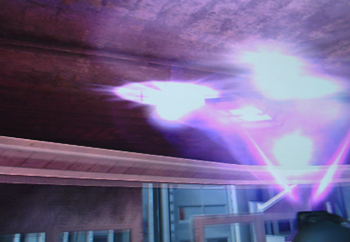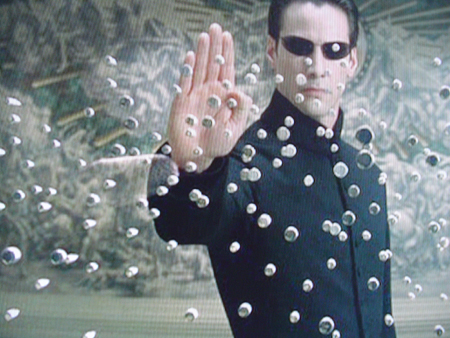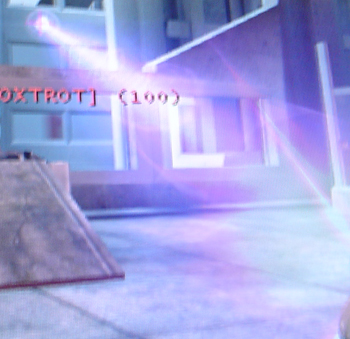A Guide to Choosing the Right 19" LCD Monitor - 7 Models Reviewed
by Kristopher Kubicki on November 30, 2004 12:04 AM EST- Posted in
- Displays
Application Analysis
The core of our LCD benchmarking comes from real application analysis. We play with a lot of monitors and it gets easier for us each time to pick out problems with an LCD just by using the right application. Here are a few quick looks at some demanding full screen applications. We already ran ColorVision's OptiCal software, so all of our monitors are calibrated and adjusted to the same curves.High Definition Video - We cheated a little bit on this portion of the analysis and handicapped all the monitors. None of these LCDs can display a true HD signal correctly without compressing pixels or cropping the image. Nevertheless, we set out to play a WMV9 1080i signal on our monitors with the interest in looking for color differences. Since our monitors have all been precalibrated, we expect the same image on each screen. Unfortunately, no amount of calibration can fix some things; we still noticed "off" reds on most of the monitors (including the Samsung 193P, the Sony, the Planar and the Dell). The BenQ, NuTech and ViewSonic occasionally managed to wash out blues a little too easily, and when looking in the right places, we could easily spot some of the differences between the 6-bit BenQ image.
The Matrix Reload, The Matrix - We use the Matrix series to test full motion video on our LCDs. Since the Matrix isn't the best movie to test color reproduction, we typically only look for motion blur or other imperfections. As expected, we noticed no fatal flaws in any of the LCDs. Although, while running some of them side by side, it became readily apparent that some monitors put a slight hint of color on the application - noticeably, the NuTech and ViewSonic monitors had a slight bluish tint.
WarHammer 40K, Dawn of War - When looking for a monitor's response time, we generally only consult first-person shooters for reference. However, those of you who have played a fast-paced game of Warcraft III or NeverWinter Nights will know that scrolling around for hours puts a severe tax on the monitor. Although we didn't notice any profound difference on the 16ms BenQ monitor, we could tell that the Sony and Planar had occasional difficulty in poorly lit areas of the game. For example, when scrolling around the last level of DOW where the majority of the level is gray ash and black soot, we would see the edge of the menu bar and status icons bleed into the ground.
Looking closer, we noticed some small differences with heavy weapons fire while scrolling on the BenQ FP931 and Samsung 193P. With enough patience, we can actually count the tracers shot over long distances, but when viewing the same scene on the Planar PE191M, the same task seems almost impossible. Attempting to do the same on the ViewSonic LCD proves futile sometimes, but not others.
Max Payne 2 - The extreme light and dark transitions in Max Payne still provide us with the sufficient criteria to benchmark transient response time; specifically, we can focus on the light and dark extremes. However, in all of the demos that we ran, we noticed virtually no difference from one monitor to another. The Samsung 193P looked a little more vibrant than its competitors, but the NuTech and ViewSonic models were displaying particularly brighter lights while maintaining the same dark hues as the SyncMaster 193P. Revisiting Max Payne with the Dell 2001FP was a little bit of a surprise. Even with the brightness set to its maximum, we were a little surprised at how much brighter the 19" LCDs were running.
Halo, Unreal Tournament 2004 - Halo and UT2K4 have very similar results, but now, we are looking for fast motion and color correctness at the same time. Again, we noticed a slightly blue tint to the BenQ monitor even after it was corrected with OptiCal. All of the monitors had a tendency to wash out, particularly in bright areas, and part of that is because we are running all of our monitors at the highest brightness levels. Specifically, the BenQ and Samsung 910V would wash out especially in bright explosions (a well-placed Redeemer usually did the trick). On occasion, the Sony SDM-934 and the Planar PE191M would blur in heavy laser battles (4 or 5 shock rifle shots firing across the screen would usually leave a small trail).

ViewSonic Q190MB
Click to Enlarge.














97 Comments
View All Comments
KristopherKubicki - Tuesday, November 30, 2004 - link
Interesting, let me look into this. My 2001FP is A00 as well and i've had mine for over a year now. (No problems though).Do you know how much of a delay there is?
Kristopher
Cat - Tuesday, November 30, 2004 - link
My boss's is A00. I'm assuming mine is as well, since I bought it a few days after he did. This was about a month and a half ago.KristopherKubicki - Tuesday, November 30, 2004 - link
Angry Kid: We couldnt get a VP912B in time for the roundup. I am working on doing an individual review on that one though.Cat: On the back of your monitor near the serial it should say the REV number, like A01 or A00. Can you tell me which number it says on all those monitors?
Kristopher
blackmetalegg - Tuesday, November 30, 2004 - link
And what's the color depth for the VP912b? It's not mentioned anywhere on Viewsonic's website and google didn't turn up anything. I'm torn between VP912b(supposed 8-bit panel) and FP937S(6-bit)...KristopherKubicki - Tuesday, November 30, 2004 - link
Ensign: Fixed.Kristopher
KingofFah - Tuesday, November 30, 2004 - link
#19, I have no clue when it comes to LCDs, so thanks for giving me that information. How many images are drawn on an LCD in a second (if they even do that at a fixed rate, i dont know)?If there is no refresh rate given, I assume that the response time could be equated to the gaming performance of the monitor. In that case I'd want the fastest possible response times, and I do not think that the price would justify it. I think image quality, speed, and clarity go to a CRT. Size, power usage, and eye care seem to be the concern for LCDs. I've got plenty of space, don't use the computer that often, and don't care about power usage.
Araemo - Tuesday, November 30, 2004 - link
Is the NuTech L921G an 8 bit or 6 bit panel? it doesn't say in the specs.How about the Planar PE191M? or the Samsung SyncMaster 193P?
I'm not trying to nitpick guys, but I've been burnt by missing specs before ("Well, the review didn't mention it, so it must not be a problem..."), so I don't want to simply assume they're 8-bit when you didn't mention them(Since that wasn't stated in the intro)
Angry Kid - Tuesday, November 30, 2004 - link
Agree with many of the others - why were none of the more recent, more high-end 19" LCDs tested?It would've been nice to see the ViewSonic VP912B FEATURED IN THE NOVEMBER GAMER BUYER'S GUIDE included.
=/
garfieldonline - Tuesday, November 30, 2004 - link
I have been working with order people, and I can say many of them prefer their resolution around 1024x768. I may be wrong, but as for LCD monitors, if they are not running at their optimal resolution, the screen tends to look a bit blur. This is not a problem with CRT monitor, things are sharp as long as the resolution is within the limit.Araemo - Tuesday, November 30, 2004 - link
"It's the same friggin reason why people buy a 50" TV instead of a small 20""I doubt it, since most people I know buy a 50" so they can sit 20 feet away and still pick out the super-model's pimples. But not many computer users sit 20 feet back from their monitors(Or even signifigantly further back with bigger screens)